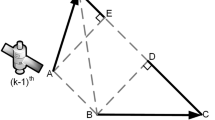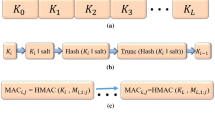Abstract
Frequency agility has been extensively used in military and commercial-communication applications due to its inherent transmission security features. This paper proposes algorithms and system-level design to intercept as well as monitor of frequency-agile signal in real-time by receiver. Receiver is assumed to have no prior knowledge of spread spectrum hopping sequence used by the frequency agile transmitter. Novelty of design is capability of simultaneously & reliably intercepting multiple frequency-agile transmissions with signal-to-noise ratio (SNR) requirement of 15dB, whereas other interceptor needs minimum SNR of 30 dB Pan et al. (IEEE Transactions on Signal Processing, 23(5):1113–1122, 1) and monitoring of intercepted transmitter upto message bits/audio level in real time. Unlike the conventional approach, this technique is independent of number of transmitters and is designed to achieve higher throughput. Additionally, it mitigates the storage requirement or memory for recording the entire spread bandwidth while intercepting and monitoring the frequency-agile signal off-the-shelf. The proposed system has been designed to process frequency-agile signal with instantaneous frequency-band ranging from 13 MHz to 31 MHz with the hop-rate of 100 hops/second. Hardware prototype of this system has been implemented on a Virtex-7 FPGA platform with 22% resource occupancy and 1.667 W of total power consumption. Subsequently, we have tested this FPGA prototype using the real-world signals with the aid of 16-bit on-board ADC, digital oscilloscope, spectrum analyzer and signal generator that produce signals of 10 hopping frequencies (21, 30, 15, 25, 31, 18, 19, 17, 29 & 13 MHz) with a hopping time of 10 msec. Finally, the performance analysis of this system has been carried out to observe the variations of the parameters like processing latency, tracker resolution and percentage of correct hop-estimation with respect to the BER.










Similar content being viewed by others
References
Pan, L., Marcellin, M. W., Ryan, W. E., & Vasic, B. (2015, November 15). Viterbi detection for compressively sampled FHSS-GFSK signals. IEEE Transactions on Signal Processing, 63(22).
Rohde & Schwarz M3TR Product-Brochure. (2019). Software defined radios multiband, multimode, multirole radio family for tactical communications. Secure Communications Product Brochure-05.00.
Rohde & Schwarz White Paper. (2015). Protecting the sky signal monitoring of radio controlled civilian unmanned aerial vehicles and possible countermeasures. Signal Analysis 8GEP 10.2015-V02.00.
Majid, A., Moradi, H., & Farhang-Boroujeny, B. Fault tolerant key generation and secure spread spectrum communication. IEEE Transactions on Wireless Communications. https://doi.org/10.1109/TWC.2017.2711617. Early Access, June-2017.
Schoolcraft, R. (1991). Low probability of detection communications waveform design and detection techniques. IEEE Military Communications Conference, 02, 832–840.
Yuan, J., Tian, P., & Yu, H. (2009, December). The detection of frequency hopping signal using compressive sensing. IEEE International Conference on Information Engineering & Computer Science, 1–4.
Sheng’en, L., & Laiyuan, L. (2009). Detection of an unknown frequency hopping signal based on image features. IEEE International Congress on Image and Signal Processing, 1–4.
Koziol, S., & Russell, S. F. (2015). A method for intercepting and demodulating slow frequency hopping DPSK signals. IEEE Texas Symposium on Wireless and Microwave Circuits and Systems (WMCS), 1–8.
Corel Technologies. Frequency hopping and burst intercept monitoring system (FHBIMS). FHBIMS Product Brochure.
Lyons, R. G. (2004). Understanding digital signal processing. Pearson Education.
Zhou, B., Peng, Y., & Hwang, D. Pipeline FFT architectures optimized for FPGAs. Research article on Hindawi Publishing Corporation, International Journal of Reconfigurable Computing, (vol 2009, Article ID 219140, p. 9). https://doi.org/10.1155/2009/21
Rappaport, T. S. (2007). Wireless communications principles and practice. Prentice Hall of India (2nd ed.).
Kumar, L., Mittal, D., & Shrestha, R. (2016). VLSI-design and FPGA-implementation of GMSK-demodulator architecture using CORDIC engine for low-power application. IEEE Annual India Conference (INDICON), 1–6.
Ferreira, C. M. S., Oliveira, R. A. R., & Gambini, H. S. (2013). Characterization of FHSS in wireless personal area. IEEE Wireless and Optical Communication Conference (WOCC), 39–44.
Hippenstiel, R., Khalil, N., & Fargues, M. (1997). The use of wavelets to identify frequency hopped signals. IEEE Conference Record of the Thirty-First Asilomar Conference on Signals, Systems and Computers (Cat. No.97CB36136), 1, 946–949.
Podder, P., Khan, T. Z., & Khan, M. H. (2014). Comparative performance analysis of hamming, hanning and blackman window. International Journal of Computer Applications, 96(18), 1–7.
Proakis, J., & Salehi, M. (2008). Digital communications. McGraw-hill New York.
Polydoros, A., & Woo, K. (1985). LPI detection of frequency-hopping signals using autocorrelation techniques. IEEE Journal on Selected Areas in Communications, 3(5), 714–726.
Ling, Q., & Li, T. (2007). A spectrally efficient frequency hopping scheme. IEEE Annual Conference on Information Sciences and Systems, 190–195.
Liu, F., Marcellin, M. W., Goodman, N. A., & Bilgin, A. (2014). Compressive detection of multiple frequency-hopping spread spectrum signals. IEEE Data Compression Conference, 415–415.
Cabric, D., Eltawil, A. M., Zou, H., Mohan, S., & Daneshrad, B. (2005). Wireless field trial results of a high hopping rate FHSS-FSK testbed. IEEE Journal on Selected Areas in Communications, 23(5), 1113–1122.
Peterson, R., Ziemer, R., & Borth, D. (1995). Introduction to spread spectrum communications. Prentice Hall.
Author information
Authors and Affiliations
Corresponding author
Additional information
Publisher’s Note
Springer Nature remains neutral with regard to jurisdictional claims in published maps and institutional affiliations.
Rights and permissions
Springer Nature or its licensor holds exclusive rights to this article under a publishing agreement with the author(s) or other rightsholder(s); author self-archiving of the accepted manuscript version of this article is solely governed by the terms of such publishing agreement and applicable law.
About this article
Cite this article
Kumar, L., Shrestha, R. A System-Level Design & FPGA Implementation for Real-Time Interception & Monitoring the Frequency-Agile Communication Signal. J Sign Process Syst 94, 1395–1410 (2022). https://doi.org/10.1007/s11265-022-01810-2
Received:
Revised:
Accepted:
Published:
Issue Date:
DOI: https://doi.org/10.1007/s11265-022-01810-2




